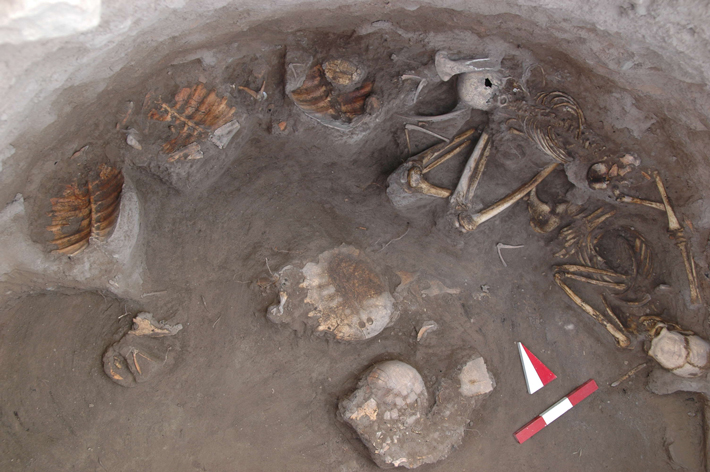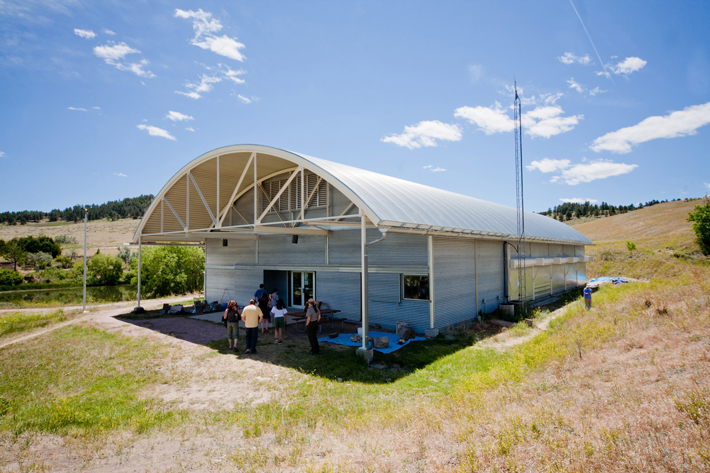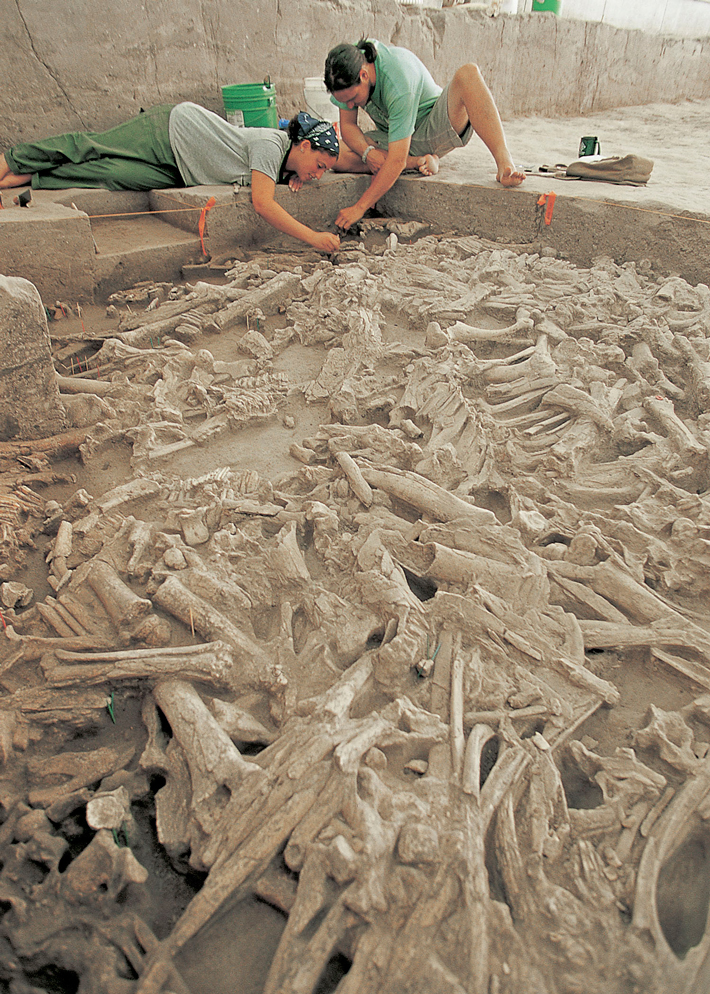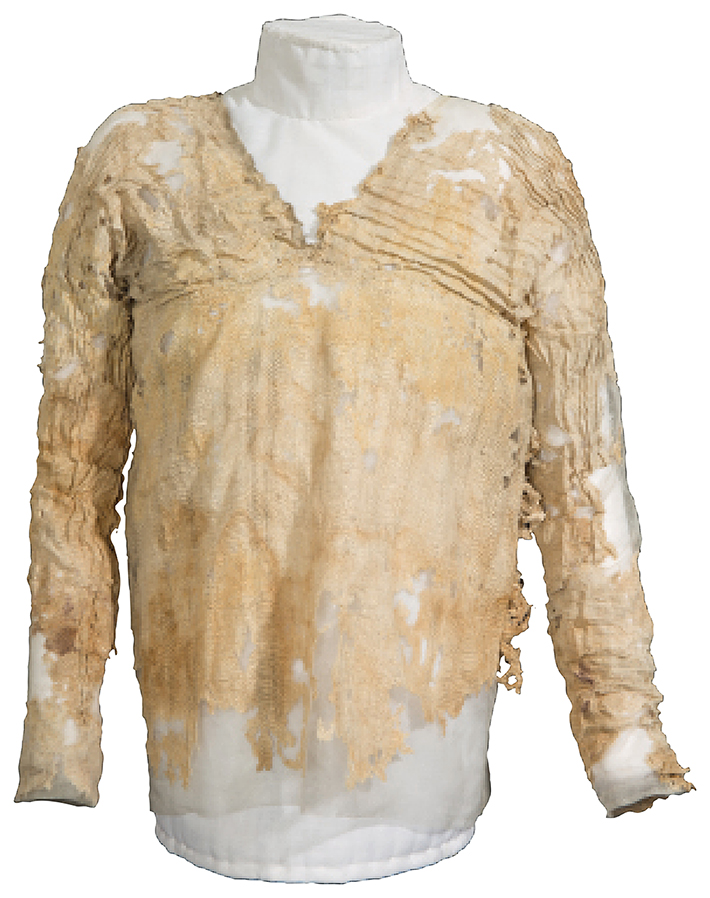From the Trenches
Let a Turtle Be Your Psychopomp
By JASON URBANUS
Monday, April 11, 2016
 Excavations at the site of Kavuşan Höyük in southeastern Turkey uncovered the unique burial of a woman and a child—the pair were interred with as many as 21 turtles, tortoises, and terrapins. The grave dates to around the sixth century B.C., and was discovered by a team led by Gülriz Kozbe of Batman University. Archaeologists were stunned to find the grave so littered with chelonian remains, most of which belonged to the Euphrates soft-shelled turtle. Turtles were not normally part of the local diet, but the evidence indicates that these were butchered and consumed as part of a funeral ritual before their shells were deposited in the grave. Researchers believe that shelled reptiles had symbolic roles as psychopomps, or guiding spirits, in the afterlife. “Very few examples of burials containing both turtle and tortoise are known,” says Rémi Berthon from France’s National Museum of Natural History. “We think that it proves that the deceased had either a high social status or a high ritual value, sort of as a shaman.”
Excavations at the site of Kavuşan Höyük in southeastern Turkey uncovered the unique burial of a woman and a child—the pair were interred with as many as 21 turtles, tortoises, and terrapins. The grave dates to around the sixth century B.C., and was discovered by a team led by Gülriz Kozbe of Batman University. Archaeologists were stunned to find the grave so littered with chelonian remains, most of which belonged to the Euphrates soft-shelled turtle. Turtles were not normally part of the local diet, but the evidence indicates that these were butchered and consumed as part of a funeral ritual before their shells were deposited in the grave. Researchers believe that shelled reptiles had symbolic roles as psychopomps, or guiding spirits, in the afterlife. “Very few examples of burials containing both turtle and tortoise are known,” says Rémi Berthon from France’s National Museum of Natural History. “We think that it proves that the deceased had either a high social status or a high ritual value, sort of as a shaman.”
Off the Grid
By MALIN GRUNBERG BANYASZ
Monday, April 11, 2016
 In 1954, two ranchers digging a small pond in Sioux County, Nebraska, stumbled across a bonebed containing the 10,000-year-old remains of up to 600 bison. The ranchers, Bill Hudson and Albert Meng, tried for years to convince professional archaeologists to take a look. Finally, Larry Agenbroad of Chadron State College saw the potential of the site and excavated there for six years in the 1970s. Further excavations have taken place at the Hudson-Meng Bison Kill, as it is known, ever since. The site represents the largest known related to the Alberta Paleoindian culture, and has left an enduring mystery—how all those bones came to rest there—that archaeologists have been trying to solve for more than 40 years.
In 1954, two ranchers digging a small pond in Sioux County, Nebraska, stumbled across a bonebed containing the 10,000-year-old remains of up to 600 bison. The ranchers, Bill Hudson and Albert Meng, tried for years to convince professional archaeologists to take a look. Finally, Larry Agenbroad of Chadron State College saw the potential of the site and excavated there for six years in the 1970s. Further excavations have taken place at the Hudson-Meng Bison Kill, as it is known, ever since. The site represents the largest known related to the Alberta Paleoindian culture, and has left an enduring mystery—how all those bones came to rest there—that archaeologists have been trying to solve for more than 40 years.
“Hudson-Meng is a unique place where visitors can come and learn about early humans’ culture and their way of life 10,000 years ago,” says Ryan Means, supervisor of the Hudson-Meng Education and Research Center. “The exciting part is knowing that there is still more evidence waiting to be discovered and interpreted.”
 The site
The site
The bonebed is the size of a football field, and much of it now lies under a climate-controlled shelter. In addition to the massive layer of bones, Alberta projectile points and tools have been found in and around the site. There have been several excavations over the years, and each research team has had its own explanation for how the bonebed formed. Agenbroad believed that hunters had driven bison over the edge of a steep cliff nearby several times over a few weeks. Larry Todd of Colorado State University and David Rapson of the University of Wyoming, who excavated there in the 1990s, theorize, instead, that the bison died naturally, and that humans occupied the site later. Mark Muñiz of St. Cloud State University, the last to excavate there, in the 2000s, has found evidence of a series of occupations, suggesting that humans traveled to the area to hunt seasonally. Visitors can watch, and even volunteer to help, as a new generation of scientists searches for additional clues.
While you’re there
Hudson-Meng is located in the Oglala National Grassland, where a memorable three-mile trail connects the bonebed to Toadstool Geologic Park, known for its haunting sandstone formations and abundance of fossils. Hearty Western country fare can be found in nearby Crawford, and several other famed attractions are not far away: Mount Rushmore or Badlands National Park can be reached in just two hours.
Dressing for the Ages
By JARRETT A. LOBELL
Monday, April 11, 2016
 Over the two-plus years Alice Stevenson has been curator of the Petrie Museum of Egyptian Archaeology in London, she has looked at the delicate cream-colored garment hundreds of times, wondering at both the fineness of its workmanship and its extraordinary age. Thought to date from nearly 5,000 years ago, the “Tarkhan Dress” was once part of a large pile of dirty linen cloth excavated by Sir Flinders Petrie in 1913 at the site he named Tarkhan after a nearby village 30 miles from Cairo. In 1977, researchers from the Victoria and Albert Museum, while sorting through the pile of textiles as they prepared to clean them, discovered the dress, remarkably well preserved. They conserved the fabric, sewed it onto a type of extra-fine, transparent silk called Crepeline to stabilize it, and mounted it for display. The dress came to be known not only as Egypt’s oldest garment, but also as the oldest woven garment in existence. Yet in the absence of a precise original archaeological context—the mudbrick tomb in which the linen had been found had been plundered in antiquity—the exact age of the dress remained a subject of contention.
Over the two-plus years Alice Stevenson has been curator of the Petrie Museum of Egyptian Archaeology in London, she has looked at the delicate cream-colored garment hundreds of times, wondering at both the fineness of its workmanship and its extraordinary age. Thought to date from nearly 5,000 years ago, the “Tarkhan Dress” was once part of a large pile of dirty linen cloth excavated by Sir Flinders Petrie in 1913 at the site he named Tarkhan after a nearby village 30 miles from Cairo. In 1977, researchers from the Victoria and Albert Museum, while sorting through the pile of textiles as they prepared to clean them, discovered the dress, remarkably well preserved. They conserved the fabric, sewed it onto a type of extra-fine, transparent silk called Crepeline to stabilize it, and mounted it for display. The dress came to be known not only as Egypt’s oldest garment, but also as the oldest woven garment in existence. Yet in the absence of a precise original archaeological context—the mudbrick tomb in which the linen had been found had been plundered in antiquity—the exact age of the dress remained a subject of contention.
In 2015, as part of the reinstallation of the museum’s collection on its 100th anniversary, Stevenson asked Michael Dee of the University of Oxford’s Radiocarbon Accelerator Unit to help her put the question to rest. Linen associated with the garment, but not the dress itself, had been dated in the 1980s to the late third millennium B.C. since the sample size required at the time might have damaged the garment. In addition, the precision of the accelerators used for radiocarbon dating is far greater today. Using sterilized tweezers and scissors, Stevenson took a tiny thread from the dress, a process she describes as nerve-racking. “You can’t help but envision the whole thing suddenly unraveling before you,” she says. In the case of linen, the smallest sample that can be tested corresponds to a piece of string about half a centimeter long, weighing between two and three milligrams. (The sample from the Tarkhan Dress weighed just 2.24 milligrams.) “You’re never pleased about removing a piece from an artifact, however small,” says Dee. “But it’s also exciting because you’re presented with the opportunity of confirming the item’s antiquity, and in many ways enhancing its cultural value.” For example, another ancient Egyptian artifact Dee tested is the Ramesses III Girdle, a woven linen waistband thought to date to the twelfth century B.C. Dee’s results corroborated that date, silencing rumors that the artifact might be a fake.
Fortunately, linen is particularly easy to analyze. “Linen is a robust plant fiber composed of the carbon-rich biopolymer cellulose,” Dee explains. “This is much easier to handle and date than proteinaceous fibers like those found in wool and leather.” Flax, from which linen is woven, also has a short growing time, making precise dating results easier to obtain. The major obstacle the team confronted was the size of the sample. “It was just so small,” Dee says, “so I am actually pleased, and somewhat surprised, we were able to produce a date.”
Perhaps even more surprising was the date itself—the Tarkhan Dress is from between 3482 and 3102 B.C., not only making it the oldest woven garment in the world, but also pushing the date of the linen back, perhaps to before Egypt’s 1st Dynasty (ca. 3111–2906 B.C.). “We’d always suspected it was old, and even if it wasn’t near the 1st Dynasty, even a 5th Dynasty dress [ca. 2500 B.C.] is still pretty old by archaeological standards for this type of object,” says Stevenson. “But this new dating has affirmed my appreciation of the garment. With its pleated sleeves and bodice, together with the V-neck detail, it’s a very fine piece of clothing. There’s nothing quite like it anywhere of that quality and of that date. It’s amazing to think it has survived some 5,000 years.”
Advertisement
Advertisement
IN THIS ISSUE
From the Trenches
Dressing for the Ages
Off the Grid
Let a Turtle Be Your Psychopomp
The Price of Tea in China
What Happened After 1492?
Women in a Temple of Death
Islam North of the Pyrenees
Mesolithic Markings
Vikings, Worms, and Emphysema
Medieval River Engineering
The Death of Joe the Quilter
Egypt’s Immigrant Elite
The First Casus Belli
Artifact
The Wild Man of the medieval world
Advertisement

Recent Issues
-
 May/June 2024
May/June 2024
-
 March/April 2024
March/April 2024
-
 January/February 2024
January/February 2024
-
 November/December 2023
November/December 2023
-
 September/October 2023
September/October 2023
-
 July/August 2023
July/August 2023
-
 May/June 2023
May/June 2023
-
 March/April 2023
March/April 2023
-
 January/February 2023
January/February 2023
-
 November/December 2022
November/December 2022
-
 September/October 2022
September/October 2022
-
 July/August 2022
July/August 2022
-
 May/June 2022
May/June 2022
-
 March/April 2022
March/April 2022
-
 January/February 2022
January/February 2022
-
 November/December 2021
November/December 2021
-
 September/October 2021
September/October 2021
-
 July/August 2021
July/August 2021
-
 May/June 2021
May/June 2021
-
 March/April 2021
March/April 2021
-
 January/February 2021
January/February 2021
-
 November/December 2020
November/December 2020
-
 September/October 2020
September/October 2020
-
 July/August 2020
July/August 2020
-
 May/June 2020
May/June 2020
-
 March/April 2020
March/April 2020
-
 January/February 2020
January/February 2020
-
 November/December 2019
November/December 2019
-
 September/October 2019
September/October 2019
-
 July/August 2019
July/August 2019
-
 May/June 2019
May/June 2019
-
 March/April 2019
March/April 2019
-
 January/February 2019
January/February 2019
-
 November/December 2018
November/December 2018
-
 September/October 2018
September/October 2018
-
 July/August 2018
July/August 2018
-
 May/June 2018
May/June 2018
-
 March/April 2018
March/April 2018
-
 January/February 2018
January/February 2018
-
 November/December 2017
November/December 2017
-
 September/October 2017
September/October 2017
-
 July/August 2017
July/August 2017
-
 May/June 2017
May/June 2017
-
 March/April 2017
March/April 2017
-
 January/February 2017
January/February 2017
-
 November/December 2016
November/December 2016
-
 September/October 2016
September/October 2016
-
 July/August 2016
July/August 2016
-
 May/June 2016
May/June 2016
-
 March/April 2016
March/April 2016
-
 January/February 2016
January/February 2016
-
 November/December 2015
November/December 2015
-
 September/October 2015
September/October 2015
-
 July/August 2015
July/August 2015
-
 May/June 2015
May/June 2015
-
 March/April 2015
March/April 2015
-
 January/February 2015
January/February 2015
-
 November/December 2014
November/December 2014
-
 September/October 2014
September/October 2014
-
 July/August 2014
July/August 2014
-
 May/June 2014
May/June 2014
-
 March/April 2014
March/April 2014
-
 January/February 2014
January/February 2014
-
 November/December 2013
November/December 2013
-
 September/October 2013
September/October 2013
-
 July/August 2013
July/August 2013
-
 May/June 2013
May/June 2013
-
 March/April 2013
March/April 2013
-
 January/February 2013
January/February 2013
-
 November/December 2012
November/December 2012
-
 September/October 2012
September/October 2012
-
 July/August 2012
July/August 2012
-
 May/June 2012
May/June 2012
-
 March/April 2012
March/April 2012
-
 January/February 2012
January/February 2012
-
 November/December 2011
November/December 2011
-
 September/October 2011
September/October 2011
-
 July/August 2011
July/August 2011
-
 May/June 2011
May/June 2011
-
 March/April 2011
March/April 2011
-
 January/February 2011
January/February 2011
Advertisement






